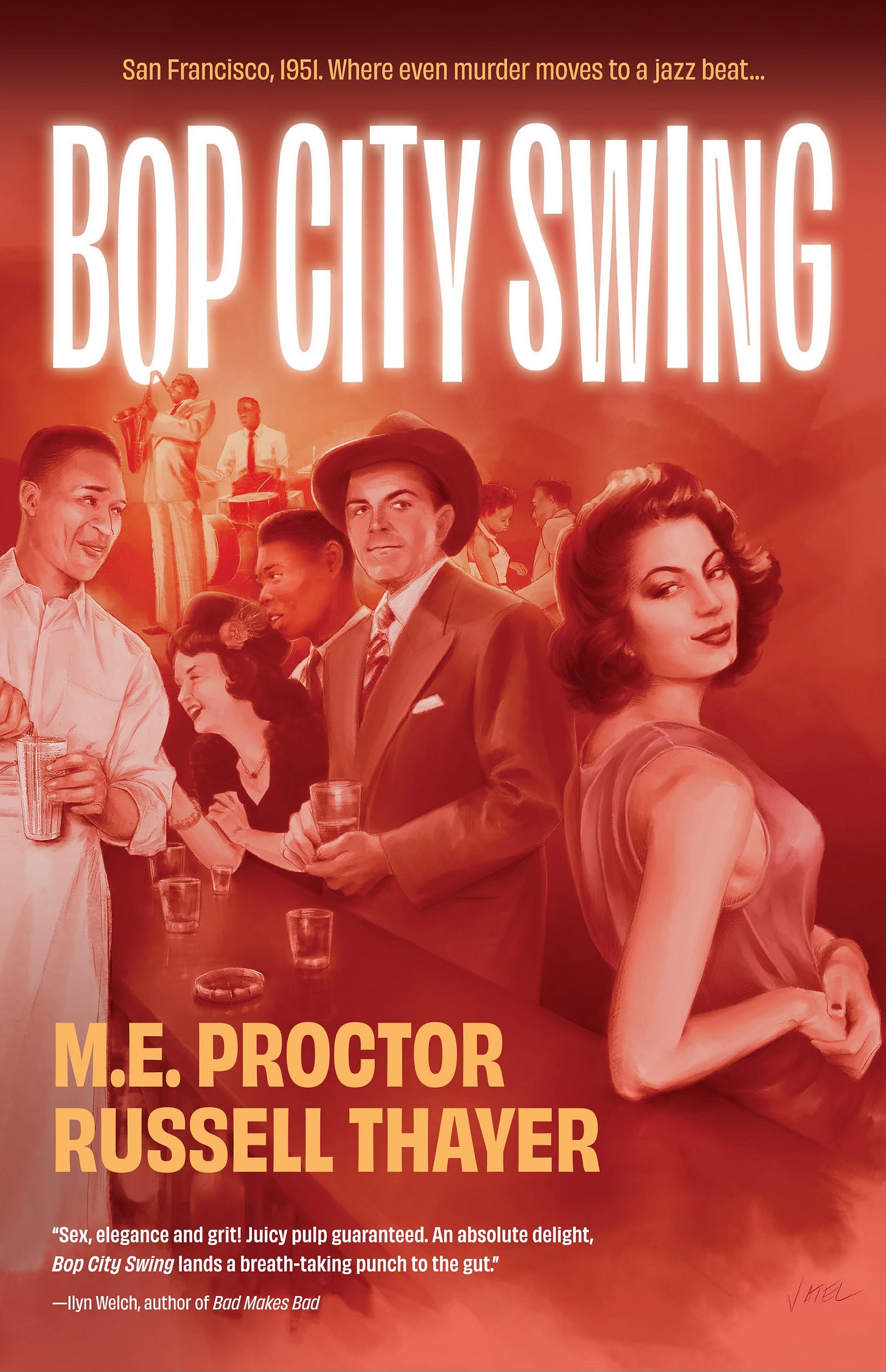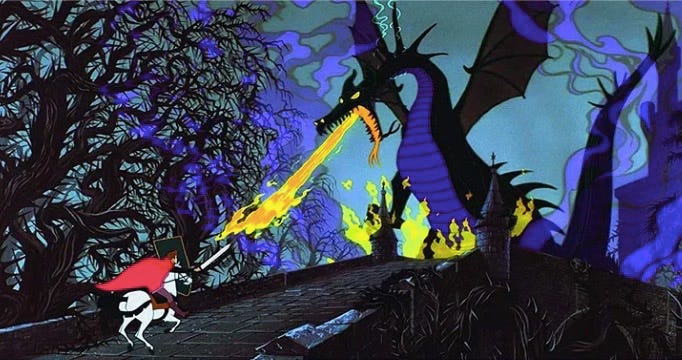First let me remind you that Bop City Swing is now available in eBook and Paperback. If you like crime classics and film noir, it’s tailormade for you.
I dedicate this week’s post to Douglas Lumsden who had the excellent idea to do a self-interview on his Substack “Under the Fedora” a few weeks ago. I’ve borrowed some of the questions (only the ones I had good answers for).
I haven’t done as many interviews or Q&A sessions as Douglas but even with my limited experience of the exercise, some questions tend to be asked pretty regularly. You must have them on the back of your mind too, so here we go.
Q. When did you start writing?
A. The answer to that question can easily turn sarcastic if taken literally, but I won’t do that. Instead I’ll go back to the first story I remember writing (no, I don’t have it anymore). I must have been 8 or 9 and the teacher gave the class an assignment: ‘Write the end of Sleeping Beauty from the perspective of the Prince.’ The scene in the Disney movie where Maleficent in Dragon form creates a forest of thorns to prevent access to the castle was (still is) branded in my brain. Scary stuff.
I’m not sure I described the sword hacking, but I clearly remember the snoring guards, the servant asleep clutching a bucket, the cook with his head in a creamy pastry … the entire palace snoozing. The story was my first public reading. I must have been both excited and quaking in my shoes. Which is why the episode stuck in my head. It’s funny that the first short story I ever got published in the U.S., seven years ago, was also called Sleeping Beauty (free to read, here, on Sick Lit Mag). Loopy. Loop the loop.
Q. Are you driven to write by a compulsion that rips at your soul, claws at your heart, and yanks your anxieties from your guts until you’re forced to bleed your stories onto the page?
A. Mmmmh, no. I write because it makes me happy. Even when I paint myself in a corner, even when I’m not at all convinced this #@!&% thing is going anywhere, I still enjoy the work. It’s the discovery that keeps me going, how stories are born out of thin air. Something that didn’t exist is suddenly there. There’s so much pleasure in that, finding out what I can come up with. It’s the rabbit out of the hat, magic.
Q. How many books have you written?
A. Written or published? Two different things. Written: twelve. Published: seven, that will become eight come September. A four-book science fiction saga, the Savage Crown. A short story collection, Family and Other Ailments, the first book of the Declan Shaw series, Love You Till Tuesday, with the next one, Catch Me on a Blue Day to release in the fall, and the recent retro-noir co-written with Russell Thayer, Bop City Swing. Add to that more than a hundred short stories published in a bunch of magazines and anthologies.
Q. What genre do you write in?
A. These days, crime, definitely, but I still like science fiction/fantasy. I occasionally write short stories in that genre, and I poke at horror when I feel the urge or I find a magazine prompt that inspires me. I doubt I’ll ever write a horror novel and I have gone as far as I want to go in science fiction with the four-books series. I feel most comfortable with crime. Variations in theme and characters are near infinite.
Q. What POV do you write in?
A. It varies. For the books, I like ‘close’ third person. Telling the story from the perspective of the main character, with a few chapters in between told from another point of view, as the narrative requires. In short stories, I do first person when the theme lends itself to it. It’s a vibe thing. Some stories work better in first person, just like the mood of a particular piece may call for present tense. I like the flexibility of short fiction. I’m not shackled to a genre or style.
Q. What time of day do you do your most productive writing?
A. I used to be incapable of writing in the morning—I’m not a morning person. These past weeks, I’ve had some burning deadlines and I started working at stories, editing them, before lunch time, but that’s exceptional. I’m at my best in late afternoon and evening. I’m in awe of writers who get up early in the morning to hammer at stories before going to work. I’m the opposite, I’ll stay up late.
Q. Do you listen to music while you write?
A. Movie soundtracks, instrumentals, jazz. I avoid heavy or fast beats, nothing loud. Some voices work really well. I’m thinking of singer David Sylvian (formerly with the group Japan). He has a weaving moody voice that gets between the lines. Slightly hypnotic. I can’t work in complete silence, I find it oppressive. Having people around me when I write doesn’t bother me. It’s white noise.
Q. Do you write every day?
A. Most days, but it isn’t a rigid rule, and often I’m editing, not writing new stuff. I might be reworking a piece, or a book chapter, tweaking things. Or I’m writing an article for Substack or a guest post, or a book review. And I like to read at the end of the day. I might skip writing completely when I’m deep in a book that I can’t put down. And yes, it makes me feel slightly guilty.
Q. How many words do you typically write in a day (on days when you write)?
A. No idea. A few years ago, I participated in NaNoWriMo (National Novel Writing Month) and I managed to write 2,000 words a day for 30 days. I can’t sustain that, it’s exhausting and soul crushing. Besides, even on days when I don’t write, I still think of the story in progress. I often resolve plot points that way. Right now, I have a great story title in mind but no narrative to attach to it. Something will come, I’m sure.
Q. How does a writing session start?
A. If it’s a short story, I’ll reread it from the beginning and make edits before getting into the new section. If I’m working on a book, I might go back ten pages to generate momentum. I’ve also written chapters ahead if I had a good scene that was clear in my head. I’ll fill in the gap later. I once wrote the book ending because I knew exactly how it would play out. Backtracking can be awkward, but losing a good idea because it’s out of sequence is worse.
Q. Do you plan your stories ahead of time?
A. A short story begins with an idea, a what if … I start writing and see where it goes. For a recent one, I knew how I wanted to end it, but I didn’t know how to get there. That’s pretty rare, usually the end surprises me. Books are different animals. I used not to plan anything, just create a situation and see where the characters take it. It’s a fun way to work, but there are risks. Getting stuck is one of them. The biggest issue for me when I have no guide lines is that I tend to ramble, and the plot slows down into what writers call ‘the saggy middle’, a boggy place where readers lose interest. And with no plan, after the first draft is completed, drafts 2, 3, etc. need a lot of reworking for consistency. I work more efficiently now. I still don’t map the entire book in detail like some authors do, but I write a rough outline, basically telling myself the story. I might end with a twenty page messy document with pieces of narrative, character bios, a rough timeline, links to research (maps, pictures). None of that is binding, things still go in unforeseen directions, new characters pop up who have something to say, but I know that I can go back to that document if I get lost in the weeds.
Q. What is your favorite genre to read?
A. I’ve always read more crime than any other genre, but I’m omnivorous, anything goes. I read non-fiction too, mostly history. The only genre I don’t read is romance. And I alternate reading in English and French. It clears my head.
Q. How do you overcome writer’s block?
A. Cross fingers, I haven’t struggled with that. If a story doesn’t work, I put it aside and work on something else. The Substack newsletter has helped. It’s a change of pace, a different style.
Q. Where do you get your ideas?
A. Frankly, I don’t know. Childhood memories are a great source, travels (I like to anchor my stories in real places), conversations, somebody I saw in the street, in a restaurant … anything can pop up in a story. Sometimes it’s just a line of text, a word combination. There’s no method to the madness … I’m a little superstitious, I’d rather not know the secret sauce.
And that’s it for now….
Other New Stuff
An interview on Cold Caller Magazine where I talk about Bop City Swing.
A 350-words horror story published at Mythic Picnic, it’s called Shadow Play. You can read all 12 selected stories here. Very cool stuff.
Here’s Shadow Play:
Suzanne finds a seat in the dark. The performance has already started. A singer is on stage, with a gamelan orchestra. It’s hot in the thatched playhouse, despite the evening breeze that ripples the wall panels. Suzanne didn’t come for the singing. She came for the wayang, the shadow puppet show.
The tour guide told the group about wayang kulit, the flat puppets, and wayang golek, the three-dimensional ones, and the performance in the local theater that night. Suzanne and a young Australian couple decided to go. In the crowded venue, Suzanne was separated from her companions.
She doesn’t mind enjoying this alone.
The singer leaves the stage and the theater goes dark. The deep rumble of a large gong focuses everybody’s attention on a backlit screen. The shadows of the puppets move with the music. It’s a battle scene, frenetic and savage, gripping. Suzanne feels the beats in her chest, the powerful rhythm. The crescendo that accompanies the stylized violence on the screen gives her goosebumps. Then the music stops and the venue goes dark. A long rumor comes from the audience, as if spectators had been holding their breath.
Soon more one-act plays are performed, some with large wooden puppets. It’s beautiful, poetic, less visceral.
People are getting up when a gong signals the evening isn’t over. The screen lights up again.
This time, the puppets are life-size. They must be heavy and cumbersome to handle, because the moves are slow, almost sleepy. One of the figures looks ragged with long hair, the other is contorted, broken. The music has slowed to a dirge, full of echoes. The feeling of sadness is unbearable. Suzanne’s eyes are blurry with tears. The woman seated next to her is sobbing. The shadow of a curved knife appears on screen, a slash, and everything goes dark.
The theater silently empties.
Suzanne waits outside for her fellow tourists. They must have left early. She walks back to the hotel.




And ... Sleeping Beauty, too!
That cartoon had a BIG impact on me.
Cool interview! You are one fascinating woman!!